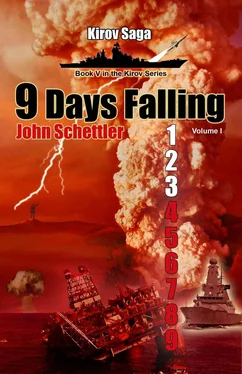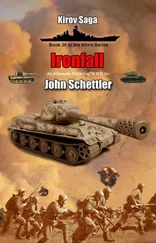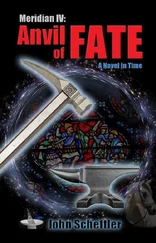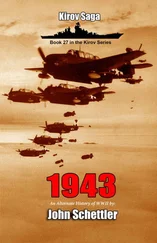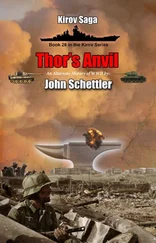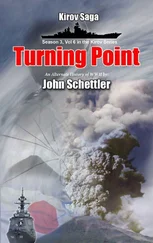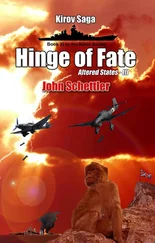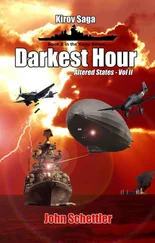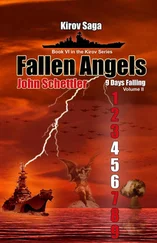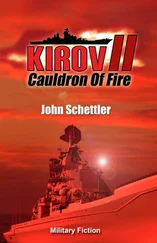“There are the two Marines in the hall, but nothing said here could be overheard. You may also take my word that nothing is being recorded or monitored. The room is completely private.”
“I will take your word on that.” Kamenski removed his glasses and cleaned them on the hem of his sweater. “And then I will tell you both something now that will bring this situation into a hard focus—it didn’t start with Kirov .”
He let that sit there for a moment, watching the reaction on Volsky’s face, his eyes shifting quietly from the Admiral to the Inspector General, who sat on the chair to his right, listing eagerly to all that was being said as he reviewed his records.
“What do you mean? Time displacement?”
“Exactly.”
“There were other incidents?”
“You, yourself are aware of at least two others, Admiral—Fedorov and Markov—so don’t be so surprised.”
“These things happened before Kirov disappeared?”
“They did,” Kamenski said flatly. “The first incident here in Russia was during the testing that became the Tsar Bomba detonation. We called it Kuz'kina Mat' , Kuzka's mother; just a little lesson Khrushchev wanted to teach the west. The Americans called it Big Ivan. It was the AN602 hydrogen bomb, the most powerful nuclear weapon ever detonated.”
“It caused time displacement?” Volsky’s eyes reflected his amazement.
“That it did. Two technicians observing the event vanished, though they were 150 kilometers away from the detonation site. We thought they were killed by the blast, until they turned up twelve days later with vranyo that no one could believe with a straight face. Yet they had something with them that proved their story was true—though we need not get into that now.”
“Amazing… We also thought the accident on Orel was responsible for moving Kirov in time in the beginning. It was only later that we discovered the effects of Rod-25.”
“The two may be related,” said Kamenski. “It seems that highly explosive events can cause these displacements. They are most unsettling. The scientists tell me it has something to do with the fabric of space and time being distorted or torn by the detonations. The blow holes in time, if you will.”
“That was just what our own Doctor Zolkin suggested,” Volsky said excitedly.
“A very wise man…Well, we began to perceive the Americans and British were secretly testing something more than their bombs back in those years. We observed several similar events in our own testing program, and confirmed that very large detonations produced other instances of time displacement. In fact…what do you think the nuclear testing program was really for, Admiral? We already knew how to make the damn things, and we knew that they worked, but once these time displacement effects were discovered people got very, very interested. We think the Americans got in on the act early with their really big tests—Castle Bravo, Ivy Mike. We knew what they were doing, of course, but our early testing produced no results. We assumed the detonation were not energetic enough, so we pumped up the mega-tonnage with the Tsar Bomba, and it worked! We believed the story those two technicians told us, because we deliberately put them there to see if anything would happen to them.”
“Astounding…” Volsky did not know what to say. “The explosion aboard Orel was from a very small warhead, however, nowhere near the scale of the detonations you mention.”
“Very curious,” said Kamenski. “And I suppose that now your Rod-25 has something to do with this. The question is—what happened, and why?”
Kapustin had been listening avidly, even as he continued to search his data base. Soon his attention was being pulled from the things Kamenski was saying to the information on his screen, and now he raised his eyebrows, clearly surprised.
“Here it is, gentlemen!” he said jubilantly. “You see, there is something to be said for the plodding, meticulous work of a records keeper. I believe I have some information to offer at this point.”
Kamenski turned his way, smiling. “Good for you, my friend. “What have you learned?”
“Rod-25 was manufactured by Rosatomica, a subsidiary of the big state enterprise overseeing the nuclear power industry. The rod was certified and shipped for live testing last year, but for some reason the test was cancelled. As one thing led to another the rod passed physical inspection and was shipped to the naval storage facility at Severomorsk. That is how it came to your ship, Admiral, though it never should have entered active service without a live test.”
“Indeed,” said Volsky. “And no one knew of its effects until we used it for the first time aboard Kirov?”
“That appears to be the case, but there is something else you may wish to know, and I’m afraid it may amount to a very great deal.” He smiled.
“Well Gerasim, don’t be stingy,” said Kamenski. “Out with it!”
“These rods…well they don’t make them individually. They come in batches, lots as we call them. Those that don’t pass physical inspection are destroyed, but in this particular lot three survived. One of those is your Rod-25.”
“You mean to say—”
“Yes, I do, Pavel.” Kapustin smiled broadly now. “There are two more!” He tapped lightly on the screen of his laptop. “And I can tell you exactly where they are.”
Thatnews interested Kamenski a great deal. “Two more,” he said, “from the same lot you say?”
“Precisely,” said Kapustin. “One is right here, at Shkotovo-16!” He was referring to a special facility south of the naval headquarters building on the bay at Fokino that was used exclusively for the unshipping of nuclear fuels and other radioactive fleet waste. It would be stored there temporarily before being transferred to another site for permanent burial, called Shkotovo-32.
“I know this site well,” said Kapustin. “I have to inspect it every year, you see. We have five burial trenches there for low-level solid radioactive waste and more highly radioactive materials, such as ion-resin exchanger slurries from our nuclear-powered submarines. And when we remove the spent fuel rods, they are also stored here and on the technical support ships assigned to the facility. Then they get shipped to the Mayak Chemical Combine reprocessing plant in Chelyabinsk. We have 8,622 spent fuel assemblies at Shkotovo-32 by my last inventory count.”
“You see, Admiral? Information can be very useful in this world—even mundane statistics like those the Inspector here must tabulate. Yet now you say a control rod from the same lot as this Rod-25 is sitting there in storage?”
“They have to replace the rods they remove from the ships, yes? There are presently thirty-seven new control rods in inventory there, and one is from lot number18726, the same as this Rod-25.”
“Very useful!” Kamenski turned to Volsky now. “Admiral, I think it would be prudent if you were to have this control rod moved to a more secure location. Something tells me we may find it very useful in the near future.”
“The other rod is in the Naval Arsenal site at Severomorsk.”
“Get that one too, Admiral. Make the request seem routine, however. No need arousing undue suspicion. I must say, Gerasim, this, as the Americans might say, is a whole new ballgame now!”
Volsky seemed to hesitate, his eyes reflecting the concern in his mind. “Just what exactly are you proposing, Mister Kamenski?”
“Nothing, at the moment—only that we should quickly secure these two control rods to prevent any unexpected…complications.”
Читать дальше
